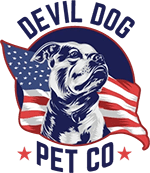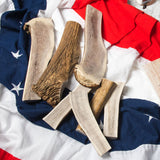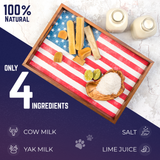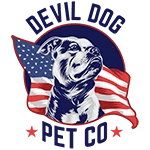Key Takeaways
- Rubber dog bones are synthetic chew toys that satisfy dogs' natural gnawing instincts.
- They are made from natural or synthetic rubber compounds for durability.
- These chew toys provide long-lasting enrichment lasting weeks to months.
- Rubber dog bones promote dental health and mental stimulation.
- They offer a safe alternative to edible chew toys by eliminating mess, calories, and safety risks.
Table of Contents
- Key Benefits of Rubber Dog Bones
- Types of Rubber Dog Bones: Materials and Design
- How to Choose the Right Rubber Dog Bone
- Rubber Dog Bones vs. Other Popular Chews
- Rubber Dog Bones vs. Other Common Chews: Head-to-Head Analysis
- Real-World Tips for Maximizing Safety and Engagement
- Best Rubber Dog Bones by Use Case
- The Devil Dog Stand: Why We Prioritize Natural Chews Over Rubber Bones
- Common Questions About Rubber Dog Bones
- The Bottom Line: Rubber Bones as Part of Your Chew Strategy
- Looking Ahead: Evolving Your Dog's Chew Program
Rubber Dog Bones: The Marines Guide to Safe Chewing
Rubber dog bones are synthetic chew toys designed to satisfy your dog's natural gnawing instincts without the mess, calories, or safety risks of edible alternatives. Made from natural or synthetic rubber compounds, these durable bones provide weeks to months of enrichment while promoting dental health and mental stimulation. Long lasting dog chews like these are ideal for owners seeking a mess-free, reusable solution.
Unlike rawhide or cooked bones that can splinter, quality rubber bones for dogs flex under pressure and wear down gradually. They're reusable, washable, and offer controlled chewing sessions, making them valuable rotation tools for responsible dog owners who prioritize safety and engagement. For more insights on choosing the right chew, check out this guide to best bones for dogs.
Many pet parents wonder how rubber options compare to other dog bones available on the market, especially when considering safety and enrichment value.
Key Benefits of Rubber Dog Bones
Dental Health and Jaw Strength
The textured surface of a dog rubber bone acts like a toothbrush, scraping plaque buildup while massaging gums during extended chew sessions. This mechanical action strengthens jaw muscles and promotes healthier teeth, especially valuable for breeds prone to dental issues. Limit sessions to 20-30 minutes, 3-4 times weekly, to maximize benefits without overworking the jaw.
Mental Stimulation and Stress Relief
Rubber bones engage multiple senses through unpredictable bounce patterns during fetch and varying resistance levels during chewing. This mental engagement releases endorphins, making them excellent tools for crate training, separation anxiety, or redirecting destructive behaviors. The consistent chewing motion provides a calming outlet similar to stress balls for humans.
Safe Outlet for Teething and Chewing Instincts
Puppies and heavy chewers need appropriate outlets for their natural gnawing drive. A properly sized rubber bone (1.5 times snout length) redirects destructive chewing from furniture to an approved target. Introduce the bone within minutes of catching unwanted chewing behavior for maximum training effectiveness.
Types of Rubber Dog Bones: Materials and Design

Natural vs. Synthetic Rubber
Natural rubber bones offer superior flexibility and are less likely to cause gum irritation, but cost more and may degrade faster outdoors. Synthetic options provide consistent durability and often include flavor infusions, though quality varies significantly, always verify food-grade, chemical-free certifications before purchasing.
Size, Shape, and Texture Variations
Standard bone shapes range from small (4-5 inches) for toy breeds to extra-large (8-10 inches) for powerful chewers. Textured surfaces with ridges, knobs, or rope-like braiding provide enhanced dental action. Firmness levels vary from puppy-soft to ultra-dense for aggressive chewers, match the resistance to your dog's jaw strength and experience level.
Scented and Flavor-Infused Options
Many manufacturers embed bacon, peanut butter, or other appealing scents directly into the rubber compound. For picky dogs, apply a pea-sized amount of natural peanut butter to jumpstart interest, then allow the embedded flavoring to maintain engagement over time.
How to Choose the Right Rubber Dog Bone
Assess Your Dog's Chewing Style and Strength
Aggressive chewers who destroy toys within hours need ultra-dense natural rubber bones with daily wear inspections. Light chewers and puppies benefit from softer, textured options that provide satisfying resistance without jaw strain. Observe your dog's technique, side gnawers can handle harder materials than straight-down biters.
Size, Weight, and Age Considerations
Select bones longer than your dog's snout to prevent swallowing, regardless of breed size. Our dog Dexter taught us that jaw strength matters more than body weight, he thrives with Monster-sized bones for maximum durability. When uncertain, photograph your dog's profile and consult sizing charts or contact manufacturers directly.
Material Safety and Certification
Prioritize FDA-certified, phthalate-free rubber bones made in facilities with food-grade standards. Avoid products with artificial dyes or strong chemical odors. Look for "Made in USA" labels and third-party safety certifications, your dog's health is worth the premium.
Rubber Dog Bones vs. Other Popular Chews
| Criteria | Rubber Bones | Nylon Bones | Natural Bones |
|---|---|---|---|
| Safety Profile | Flexible, gradual wear | Rigid, potential splintering | Risk of sharp fragments |
| Mess Factor | Low, easy to clean | Low, may leave plastic shavings | High, grease, crumbs, stains |
| Longevity | Weeks to months | Months | Days to weeks |
| Dental Benefit | Moderate, mechanical cleaning | Moderate, abrasive action | High, natural scraping |
| Digestibility | Not edible | Not edible | Fully edible (if raw/natural) |
Rubber Dog Bones vs. Other Common Chews: Head-to-Head Analysis

Rubber vs. Nylon Bones
| Criteria | Rubber Bones | Nylon Bones |
|---|---|---|
| Flexibility | Flexible, safe grinding action | Rigid, may splinter with aggressive chewing |
| Scent/Flavor Options | Can be infused with natural flavors | Usually odorless, limited appeal |
| Puppy Safety | Softer options available for teething | Too hard for developing teeth |
| Durability | Weeks to months depending on chewer | Months but higher tooth damage risk |
Rubber vs. Natural Edible Chews
While natural chews like elk antlers and bully sticks provide nutritional benefits and complete digestibility, rubber dog bones offer zero-calorie enrichment with no mess or staining. Natural options deliver superior dental scraping action and satisfy instinctual consumption drives, but require careful sizing and supervision to prevent choking. Rubber bones excel as rotation tools between natural chew sessions. For more on the benefits of raw options, see our article on raw bones for dogs.
Rubber vs. Rope Toys
Rope toys excel for interactive tug games but fray quickly during solo chewing, creating ingestion hazards. Rubber bones maintain their shape indefinitely, provide consistent dental action, and clean easily with soap and water. Smart owners use rope for supervised play and rubber for managed solo enrichment sessions.
Real-World Tips for Maximizing Safety and Engagement
Safe Use Techniques
Inspect every dog rubber bone before each session, removing any chew showing cracks, loose pieces, or sharp edges. Supervise the first 3-5 sessions to gauge your dog's chewing style and ensure proper size selection. For crate use, secure the bone with a short tether to prevent dropping and potential paw injuries.
Cleaning and Maintenance
Hand wash rubber bones weekly with mild dish soap and warm water, scrubbing textured areas with a soft brush to remove saliva buildup. Rinse thoroughly and air dry completely before storage. Heavy droolers may require more frequent cleaning to prevent bacterial growth and maintain appeal.
Troubleshooting Common Issues
Dogs losing interest typically respond to scent refreshing, rub with a damp cloth and apply fresh peanut butter sparingly. Gum irritation suggests switching to softer rubber or reducing session length. If your dog attempts to swallow pieces, immediately upgrade to a larger size and reassess chewing supervision needs.
Best Rubber Dog Bones by Use Case
Best for Aggressive Chewers
KONG Extreme (black) delivers maximum density for power chewers, while Nylabone Power Chew DuraChew provides textured surfaces for enhanced dental action. Both withstand months of heavy use when properly sized. Benebone Wishbone offers unique shape variety for dogs bored by traditional bone forms. If you're seeking more options for tough chewers, explore our long lasting dog chews collection.
Best for Puppies and Light Chewers
KONG Puppy (pink/blue) uses softer rubber compounds perfect for developing teeth, while Nylabone Puppy Chew provides gentle teething relief with size-appropriate dimensions. Petstages ORKA bones combine moderate firmness with appealing mint scenting for reluctant chewers.
Best Natural and Chemical-Free Options
West Paw Qwizl uses FDA-approved Zogoflex material that's guaranteed non-toxic and recyclable. Planet Dog Orbee-Tuff bones feature natural rubber construction with embedded mint oil for fresh breath benefits. Both brands offer lifetime replacement guarantees for manufacturing defects.
The Devil Dog Stand: Why We Prioritize Natural Chews Over Rubber Bones

Rubber dog bones serve as solid enrichment tools, but they don't replace the dental, behavioral, and nutritional power of naturally shed elk antlers, Himalayan yak cheese, and grass-fed bully sticks. Our Marine-rooted philosophy demands proven results, natural chews deliver complete digestibility, mineral nutrition, and instinct satisfaction that synthetic alternatives simply cannot match. For a deeper dive into the pros and cons of different chew types, visit the Devil Dog Blog.
We recommend rubber bones as rotation tools between natural chew sessions, not as primary enrichment. Our dog Dexter taught us this lesson, the right chew isn't just a toy, it's mission-critical equipment for mental health, dental care, and behavioral management. Choose natural first, supplement with rubber for variety, and always prioritize safety through proper sizing and supervision.
Common Questions About Rubber Dog Bones
Are rubber dog bones safe for all dogs? Most dogs can safely use rubber bones when properly sized and supervised. Choose bones longer than your dog's muzzle and inspect regularly for wear. Puppies need softer compounds, while aggressive chewers require ultra-dense options. For more information on rubber toy safety, see this ASPCA guide to dog care rubber toys.
How often should I replace a rubber bone? Replace immediately when cracks, loose pieces, or sharp edges appear. Well-maintained rubber bones typically last 2-6 months depending on chewing intensity and frequency of use.
Can rubber bones improve dental health? Yes, the chewing action helps scrape plaque and massage gums. However, rubber dog bones provide mechanical cleaning only, unlike natural chews that deliver minerals and complete digestibility for comprehensive oral health.
What if my dog swallows rubber pieces? Remove the bone immediately and monitor for distress. Small pieces usually pass safely, but contact your veterinarian if you observe vomiting, lethargy, or appetite loss. Prevention through proper sizing remains crucial. For official safety advice, refer to this FDA update on bones for dogs.
The Bottom Line: Rubber Bones as Part of Your Chew Strategy
Rubber dog bones earn their place in responsible dog ownership as reliable enrichment tools that deliver consistent mental stimulation without the variables of edible chews. They excel for crate training, separation anxiety management, and providing safe outlets for destructive chewing behaviors. The key lies in viewing them as rotation tools rather than primary solutions.
Smart owners integrate rubber bones strategically, using them between natural chew sessions to maintain engagement without overloading on calories or rich proteins. While they can't match the instinct satisfaction and nutritional benefits of elk antlers or bully sticks, they offer mess-free convenience and indefinite reusability that busy households appreciate.
Marine-Level Bottom Line: Choose natural chews for primary enrichment, supplement with quality rubber bones for variety and convenience. Always prioritize proper sizing, regular inspection, and supervised introduction regardless of your selection.
Looking Ahead: Evolving Your Dog's Chew Program

As your dog ages, their chewing needs will shift dramatically. Puppies graduate from soft rubber to harder compounds, adult dogs may develop preferences for specific textures or shapes, and senior dogs often require gentler options as dental health changes. Monitor these transitions and adjust your rubber bone selections accordingly.
Consider seasonal rotation strategies, harder rubber bones for winter indoor entertainment, softer options during teething phases, and backup selections for travel or boarding situations. The most successful chew programs combine multiple types and adapt continuously based on your dog's evolving needs, energy levels, and behavioral challenges.
Remember that no single chew type solves every enrichment need. Build a comprehensive toolkit that includes natural options for nutrition and instinct satisfaction, rubber bones for consistent availability, and interactive toys for mental stimulation. This approach ensures your dog remains engaged, healthy, and behaviorally balanced throughout their lifetime.
Frequently Asked Questions
How do rubber dog bones promote dental health compared to other chew toys?
Rubber dog bones have textured surfaces that scrape plaque and massage gums, acting like a natural toothbrush during chewing. Unlike hard chews that risk tooth fractures, rubber flexes under pressure, providing safer, controlled dental exercise that strengthens jaw muscles without damaging teeth.
What are the differences between natural and synthetic rubber dog bones, and how do I choose the best one for my dog?
Natural rubber is derived from rubber trees and tends to be softer and more eco-friendly, while synthetic rubber offers greater durability and resistance to aggressive chewing. Choose based on your dog's chewing strength and sensitivity, natural rubber suits moderate chewers, synthetic is better for power chewers needing long-lasting toys.
How can rubber dog bones help with mental stimulation and managing destructive chewing behaviors?
Rubber dog bones engage dogs through varied textures and unpredictable bounce, keeping their minds active and focused. This mental stimulation releases calming endorphins and redirects chewing away from destructive targets, making them effective tools for anxiety, crate training, and boredom relief.
What safety considerations should I keep in mind when using rubber dog bones for puppies and aggressive chewers?
Always select appropriately sized rubber bones to prevent choking hazards and supervise chewing sessions, especially with puppies whose teeth and jaws are still developing. For aggressive chewers, opt for high-quality, durable rubber designed to flex rather than splinter, and retire any toy showing significant wear or damage.






